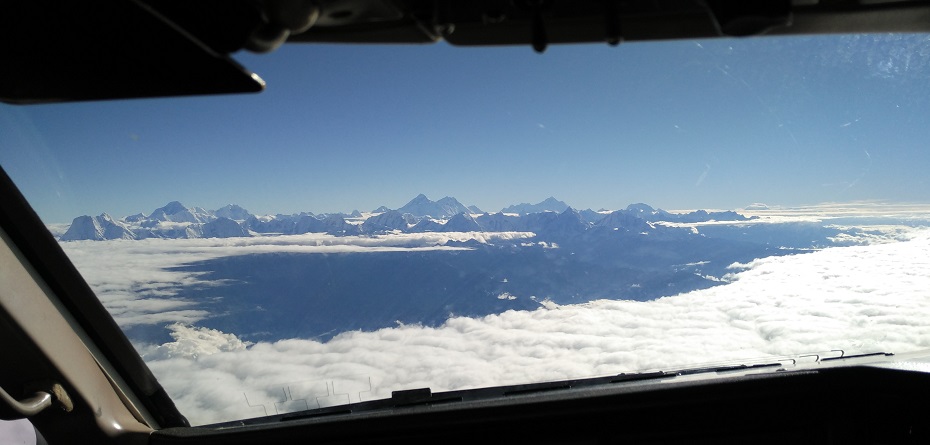
First view of Everest from the cockpit. Photo credit: Sumit Chakraberty
On a “mountain flight” from Kathmandu, face pressed against the window of our small plane as it flew over snow-capped peaks rising above 7,000 meters, all the way to the 8,848-meter-giant Everest and back, I contemplated how unique a place is Nepal.
It shares the world’s tallest mountain with China. But it’s not just about Everest. The beautiful hills and green valleys that lead up to Nepal’s Himalayan range are open and inviting. Nepalis and Indians don’t even need visas to travel between the two countries.
It made me daydream about Nepal as a cool destination for digital nomads, who can simply look up from their laptops at the surrounding lofty mountains for inspiration. Why can’t Pokhara, a gateway to Himalayan treks, be a Bali or Chiang Mai or Puerto Viejo, which are among the favorite haunts of globe-trotting digital nomads?
The question teased the minds of a few others who took the mountain flight with me that morning. They were a bunch of investors and entrepreneurs from India, Bangladesh, Thailand, and Hong Kong, who had converged in Kathmandu for a conclave organized by M&S Next Venture Corp. It’s a Nepali private enterprise’s initiative to get a co-working space and accelerator going in Kathmandu and other hubs.
A post-event excursion to die for
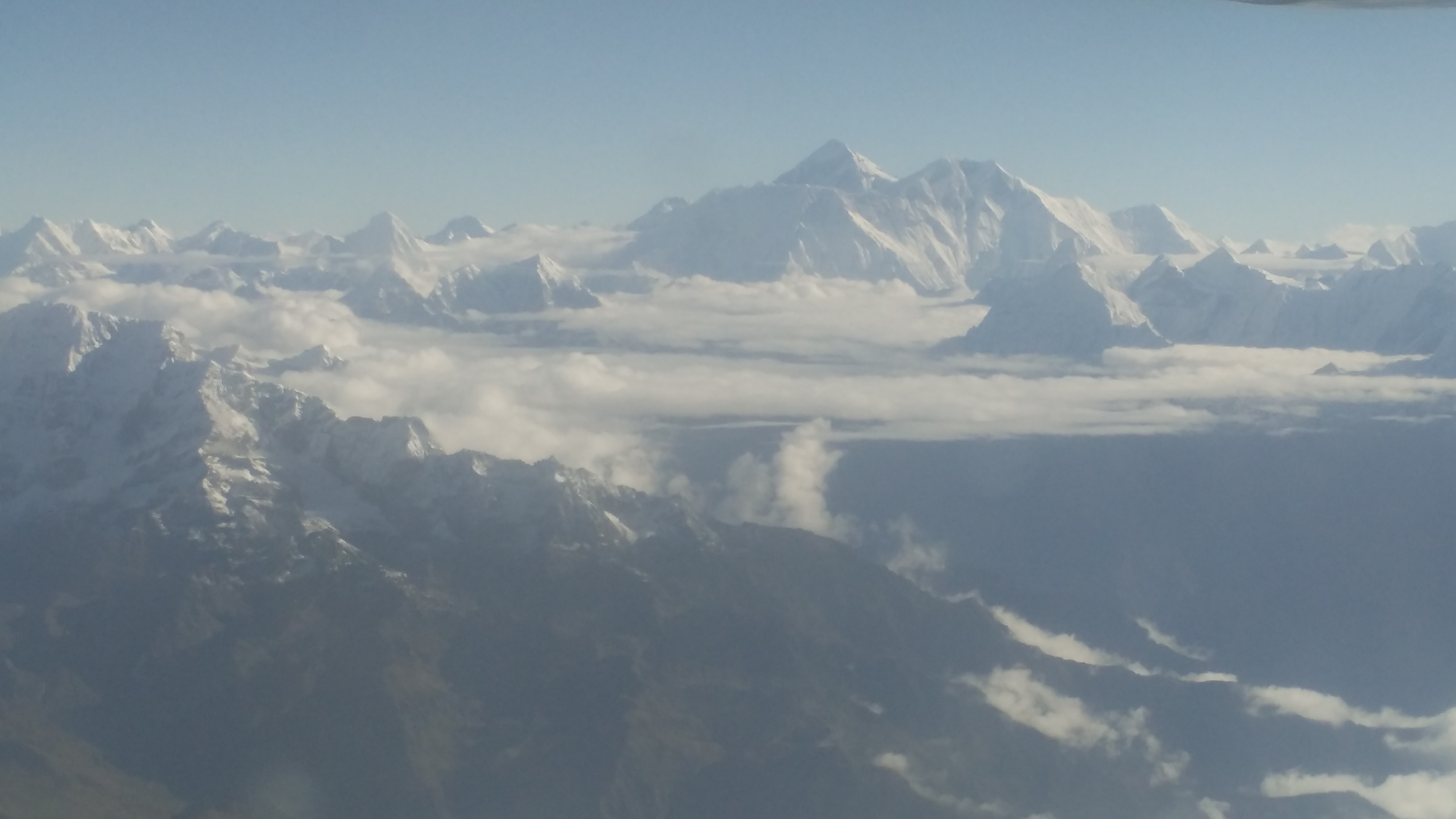
Flying past Everest. Photo credit: Sumit Chakraberty
“This is the best post-event excursion ever,” remarked Amarit Charoenphan, co-founder and CEO of Thai co-working space Hubba, with a grin, as we got off the mountain flight. If the lure of the mountains, and a nascent entrepreneurial scene, can draw people like Amarit to a startup conclave in Kathmandu, it stands to reason that Nepal can attract digital nomads too.
Kavi Raj Joshi, founder and MD of Next Venture Corp, enthused by the oohs and aahs on the mountain flight, is already making plans for a startup trek to the base camp of Everest for next year’s conclave. The possibilities are endless.
But natural beauty alone does not make a digital nomad destination. You need digital infrastructure, co-working spaces, and startup activities to go with it.
When you go around Kathmandu and still see the ravages of last year’s massive earthquake, the dusty haze in the air from pavements dug up for road relaying work, people walking about with masks in this surreal atmosphere, you begin to be sceptical. But it’s really the places beyond Kathmandu valley, closer to the mountains, which will attract the tech crowd that wants to get away from urban centers. What they need most of all is connectivity.
The Chindia connection
Interestingly, despite Nepal being one of the least developed countries in the world, its average internet connection speed of 3.8 mbps is nearly two-thirds the global average of 6.1 mbps, and better than the 3.6 mbps in India, as per Akamai’s latest state of the internet report for the second quarter of 2016. And this is after the massive destruction of telecom infrastructure in last year’s devastating earthquake in Nepal. Akamai says Nepal is one of the countries in Asia seeing the fastest improvement in net connectivity.
Of course, the caveat is that most of the internet connections are in and around Kathmandu valley, and not in the places where digital nomads would want to go. But the need to cater to tourists has brought wifi to Pokhara and even the trekking routes to Annapurna and Everest.
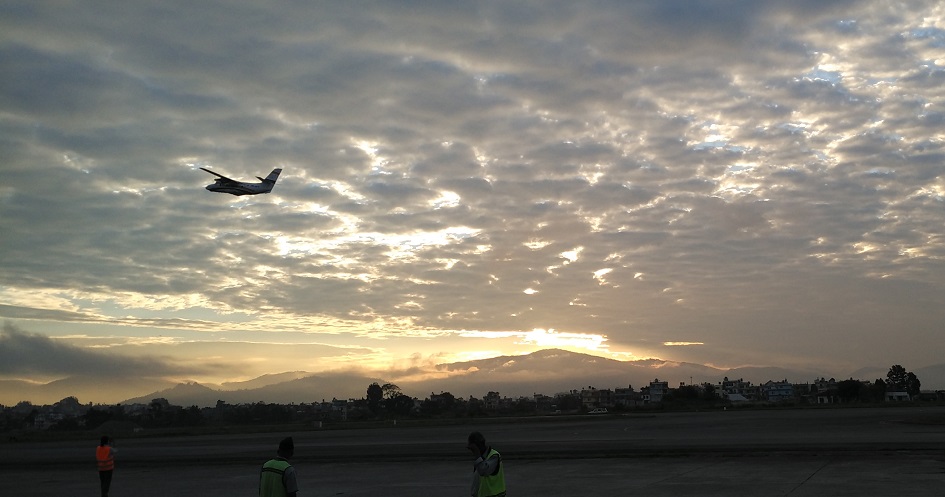
The first mountain flight to Everest takes off at dawn. Photo credit: Sumit Chakraberty
What’s more, this could see rapid improvement with China Telecom recently linking its optical fiber network with that of Nepal Telecom. This connects Nepal directly with Hong Kong Data Center, one of Asia’s biggest data centers.
Nepal also has broadband links with India’s BSNL in the southern parts of the country. “Chindia” was a term coined to denote the collective impact of two of the world’s largest and fastest growing economies. Could the little ‘n’ in the middle of Chindia be Nepal, making the most of being sandwiched between two tech giants?
Chicken and egg problem
Geopolitical tussles coupled with political instability and poor governance in Nepal have made its proximity to China and India more a bane than a boon in the past. But entrepreneurship has a way of bridging divides and creating new possibilities. This was a thread running through the startup conclave in Kathmandu.
Mahesh Murthy, managing partner of Seedfund, one of India’s leading early stage VC funds, likened the infrastructure issue to a chicken-and-egg problem. The more startup activities there are, higher is the pressure on government to give a push to enabling infrastructure – and vice versa.
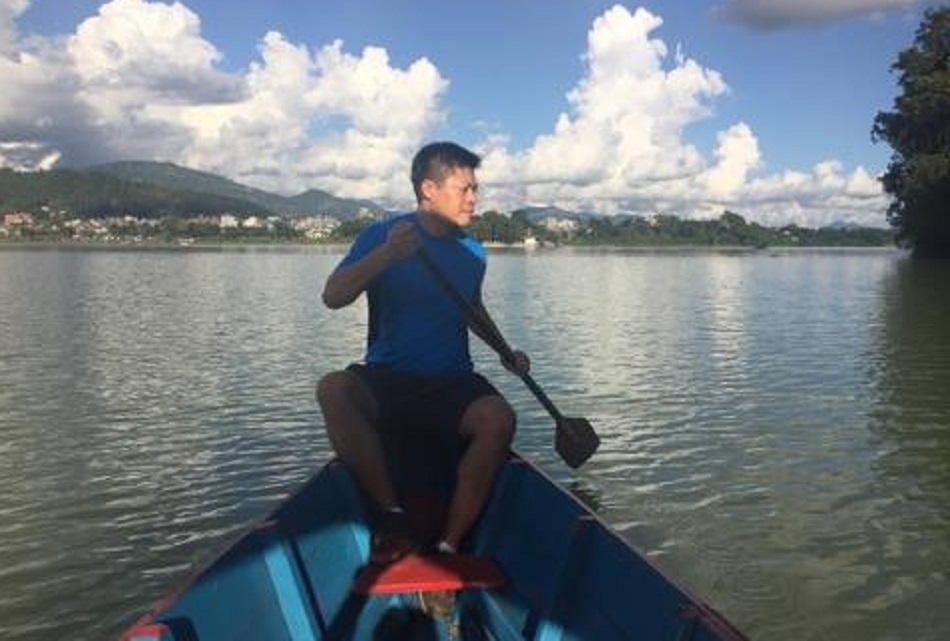
Joseph Jeong, mentor to Chinaccelerator, learning new skills on Pokhara lake in Nepal.
Joseph Jeong, a Wall Street veteran and now a mentor to Chinaccelerator among other things, sees potential for Nepal to leapfrog into new technologies. Armed with an entrepreneurship teaching certificate from MIT, he is looking for ways to give this a push.
One of his potential partners in this is Sherpa Adventure Gear, a US-based firm that develops and makes its products in Nepal. Its founder, Tashi Sherpa, also went to MIT. The Sherpas are hardy mountain people who are legendary climbers of Everest. Tenzing Norgay, who was the first to climb Everest along with Edmund Hillary, was a Sherpa.
As heady as Raksi
Joseph and I, along with Amarit from Thailand, paid a visit to the Microsoft Innovation Center in Kathmandu, which has been running support and training programs for entrepreneurs, students, and educators. Joseph conducted a workshop on thinking out of the box, modelled on the MIT entrepreneurship program. It involved working in groups to come up with “crazy” tech solutions to everyday problems. The enthusiasm of the young techies, some of whom were from India, was palpable.
Later, over a traditional Nepali dinner accompanied with Raksi, a powerful rice and millet liquor, the Microsoft center’s director, Allen Bailochan Tuladhar, told me that Nepal had a fair number of techies coming out of its engineering colleges, but they mostly migrated. Now the effort is to engage them locally, as entrepreneurial opportunities rise.
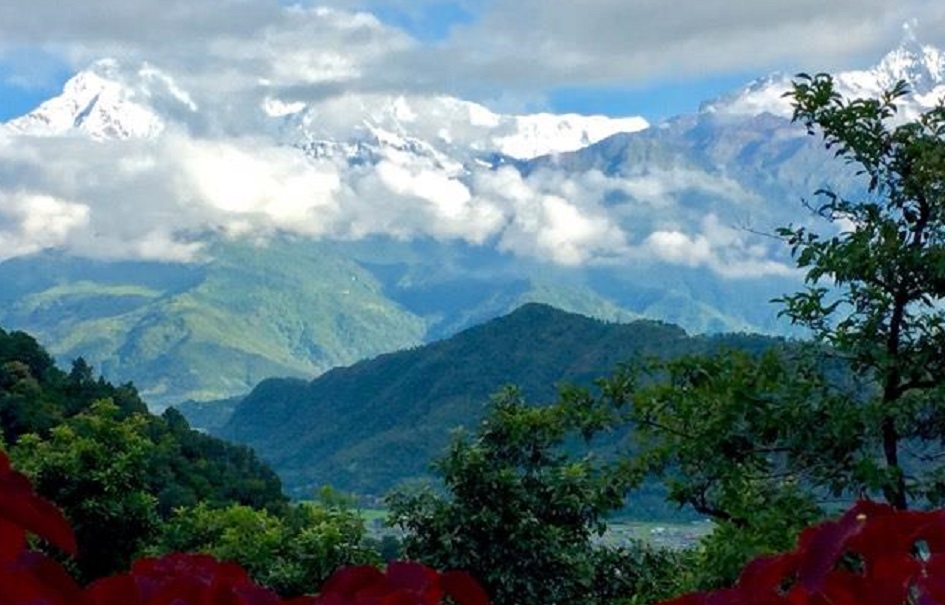
A view of the Himalayas from Pokhara. Photo credit: Joseph Jeong.
To many, it may seem far-fetched to think of Nepal as anything other than a destination for tourists. But Amarit pointed out that Thailand too used to be known only for risque vacations and the Hangover films shot there.
Things began to change in 2012. Startup events took place, co-working spaces came up, and a tech ecosystem emerged. Chiang Mai in the mountainous northern Thailand became a haunt for digital nomads.
In 2012, barely three startups got funded in Thailand. This year, more than 80 have got funded already. The amount of funding is 50x what it was just four years ago. “It has happened before. It will happen again,” Amarit told the eager audience at the Kathmandu conclave.
Start packing your bags, nomads
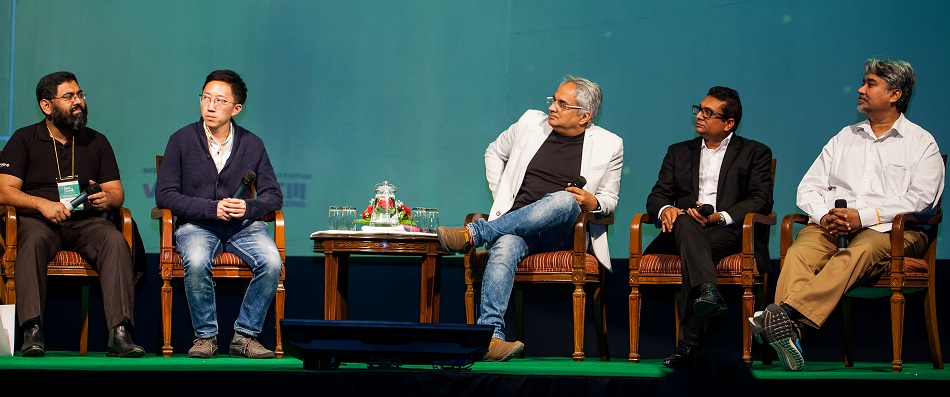
Minhaz Anwar, head of Grameenphone accelerator in Bangladesh, Amarit Charoenphan, co-founder of Hubba in Thailand, Mahesh Murthy, managing partner of Seedfund in Mumbai, Shahil Agarwal, MD of Shanker Group in Nepal, and Ajeet Khurana, angel investor from Mumbai, India. Photo credit: M&S Next
Minhaz Anwar, head of the Grameenphone accelerator in Bangladesh, who was also at the conclave, feels the initial push has to come from committed individuals in the local ecosystem. Minhaz himself is an example, from his native land, and so is Kavi Raj Joshi, who started an entrepreneur cell in his alma mater Kathmandu University back in 2011.
Now, he has got the M&S Next co-working space and accelerator off the ground in partnership with Sambhav Sirohiya, whose family owns the Kantipur Media Group. The next step is to launch a startup fund with seed money from well-off Nepalis eager to see entrepreneurship take off in their country.
Kavi also likes the idea of hubs for digital nomads, a topic which cropped up repeatedly at the conclave. He was busy making plans to rope in real estate businesses and restaurateurs when I last saw him waving me off at Kathmandu airport.
Digital nomadism is becoming more pragmatic by the day, thanks to connectivity and a host of apps for remote work and collaboration. It’s not for everyone. Many prefer to stay rooted to familiar surroundings and people. But for those constantly wondering what’s beyond the next hill, it won’t get much better than Nepal once it gets into the entrepreneurial act.
See: In the shadow of Everest, a Startup Valley begins to emerge
This post Pack your bags for a startup trek to Everest base camp appeared first on Tech in Asia.
from Tech in Asia https://www.techinasia.com/pack-bags-startup-trek-everest-base-camp
via IFTTT
No comments:
Post a Comment